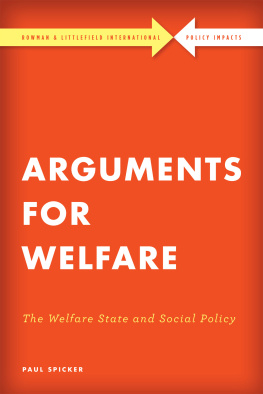Columbia University Press
Publishers Since 1893
New York Chichester, West Sussex
cup.columbia.edu
Copyright 2006 Columbia University Press
All rights reserved
E-ISBN 978-0-231-50117-0
Library of Congress Cataloging-in-Publication Data
Schneider, Jo Anne, 1959
Social capital and welfare reform : organizations, congregations, and communities /
Jo Anne Schneider.
p. cm.
Includes bibliographical references and index.
ISBN 0231126506 (cloth: alk. paper)ISBN 0231126514 (pbk.)
1. Public welfareUnited States. 2. Social capital (Sociology)United States. I. Title.
HV95.S353 2006
361.250973dc22
2005048411
A Columbia University Press E-book.
CUP would be pleased to hear about your reading experience with this e-book at .
This book has been a journey of more than 10 years with many people and institutions providing support along the way. There are many more than I can name here. First and foremost, I wish to thank the families and organizations that shared their experience with me and the other researchers involved in the various projects. Several organizations and community members deserve special thanks: Ed Schwartz and the staff at the Institute for the Study of Civic Values, Colleen OConnell, Kristen Rantanan, Reverend Olen Arrington Jr., Olatoye Baiyewu, Guida Brown, Tony Garcia, Dan Melyon, Marcus White, Jim Bartos, and Wendy Humphreys.
State government officials in both Pennsylvania and Wisconsin graciously provided data and facilitated research for the project. I particularly thank Edward Zogby, David Florey, Don Jose Stovall, Dennis Putze, Adeline Robinson, Jim Kennedy, Ed Kamin, Jeffrey Sachse, J. Jean Rogers, and Eliza Lebkicher.
Many students from several colleges worked with me in conducting this research. Most were involved in internships, service learning classes, independent studies, and graduate thesis and dissertation work while attending Bryn Mawr, Haverford, Hope College, the University of Pennsylvania, the Community College of Pennsylvania, the University of WisconsinParkside, and University of WisconsinMilwaukee, among others. I am grateful for their assistance. Colleagues from the University of WisconsinParkside and the University of WisconsinMilwaukee were also integral parts of the Neighborhood Settlement House research team, and Maria Lydia Spinelli, an independent researcher, worked on the Kenosha Social Capital Study. Several students and colleagues deserve particular recognition. In Philadelphia, they include Robin Ebright, Melissa Smiley, Mathew Wickens, Julie Simon, and Sophia Javid. The Kenosha research project team included Theresa Embury, Maria Lydia Spinelli, Carol Jones, Calvin Lucas, Tania Rodriquez, Karen Szalapski, Elda Torres, Traci Rabelhoffer, Marin Rocha Jr., Latisha Riser, and Meghan Mumford. Milwaukee research was conducted by James Harris, Michael Barndt, Florence Kyomugisha, Amanda Beaver, Katie Cahoon, Theresa Embury, Mildred Spann, and Anne Statham. Regina Miller, Melanie Grant, Lane Blaquiere, and Jason Brady assisted in organizing data for analysis.
Photographs from Milwaukee and Kenosha were provided by Tom Fritz Studio. Joseph Labolito supplied photographs of Philadelphia. Initial design for tables and figures was done by Robert Cronan, Lucidity Design.
Funding for the research came from the Philadelphia Private Industry Council, the Petit foundation, the Aspen Institute Non-profit Sector Research Fund, and the Palmer Foundation. The Annie E. Casey Foundation was instrumental in providing support for development of the manuscript and publication assistance for tables, photos and other costs for the book. I particularly want to thank Doretha Carter, Audrey Jordan and Ralph Smith at the Casey Foundation for their ongoing support. A companion policy report to the book, The Role of Social Capital in Building Healthy Communities, is available through the Casey foundation. Analysis of the relationship of social geography and social capital, originally included in this manuscript, is also available as a Casey foundation report: Social Capital and Social Geography.
A number of colleagues and friends provided helpful comments on earlier drafts of the book. I am especially thankful to Marcella Ridlen Ray, Arthur McKee, Michael Foley, Richard Wood, and Bob Wineburg. Alison Anderson and Ellen Coughlin provided editorial assistance. I am also grateful to John Michel for his guidance in developing this project.
Finally, I thank Virginia Hodgkinson and the staff at the Center for the Study of Voluntary Organizations and Service at Georgetown Public Policy Institute, Georgetown University, and Dean Hoge, Michael Foley, and the staff at the Life Cycle Institute, Catholic University, for providing the supportive institutional environments needed to develop this book.

Jaysa moves from welfare to work, taking a day-care job at the nonprofit that hosted her community-service job placement. Jaysa had become part of the close network of program participants and staff at the agency, establishing trusting friendships through shared culture. She uses the resources of the social service agency to supplement her wages and provide social supports for herself and her children. Connections allow Jaysa to fulfill the goals of welfare reform, yet she earns poverty-level wages. Although her abilities fit well with this social service agency, she has not yet developed the skills or connections to find a better-paying job.
An interfaith coalition develops a model program that teams church members with low-income families to help them negotiate between the worlds of work, family, and government aid. Despite important successes, the program runs into several problems. Limited funding through short-term grants makes it difficult to keep staff with appropriate skills. More important, some churches find that the families they intend to help have problems beyond the skills of volunteers. Even with a well-designed program and connections to organizations that can successfully implement programs, this initiative runs into structural problems that cause it to be discontinued after one year.
The 1996 U.S. welfare reform legislation depends on the ability of states and localities to move large numbers of people on public assistance from welfare to permanent work paying family-supporting wages. The Personal Responsibility, Work Opportunity Reconciliation Act of 1996 ended the entitlement to cash and medical assistance for low-income people with children that had existed in the United States since the 1930s (Handler and Hasenfeld 1991;Katz 1989). Federal Aid for Families with Dependent Children (AFDC) was replaced by a block-grant system that gives states enormous flexibility in designing their programs, provided that they prove that an increasing percentage of their welfare caseload are engaged in work-related activities. Recipients are permanently barred from getting any public assistance after receiving aid for a cumulative five years over a lifetime. Like Jaysa, many welfare recipients have found jobs under the new system. However, again like Jaysa, a large number do not earn enough to fulfill their basic needs without either government or private supports.











